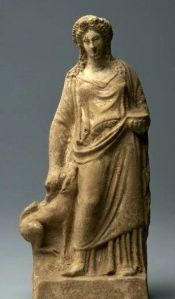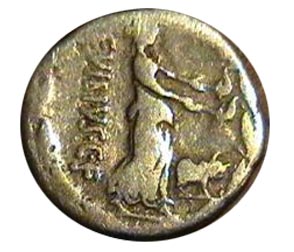The number of guests at dinner should not be less than the number of the Graces nor exceed that of the Muses, i.e., it should begin with three and stop at nine. (Marcus Varro)
I have a suckling pig in my refrigerator. Over the next three days I’ll narrate his transformation from corpse to recipe to Christmas dinner. Along the way I’ll offer words from the dead and the living, write of rituals that bond family and also offer ways I purify, I atone–a personal journey into a roasting pan, the underworld, and a new cycle of the earth round the sun. Let’s begin the begin.
Dig under volcanic ash at Pompeii and you discover the fresco of a pig being led to sacrifice. Shedding of blood, offering of flesh binds heaven and earth together; this ancient ritual speaks to us out of the past, speaks for the dead who found the sacred and profane in Sus scrofa domesticus.
Marcus Terentius Varro writes of this omnivore in On Agriculture,
The Greek name for the pig is ὕς, once called θῦς from the verb θῦειν, that is, ‘to sacrifice’; for it seems that at the beginning of making sacrifices they first took the victim from the swine family. There are traces of this in these facts: that pigs are sacrificed at the initial rites of Ceres; that at the rites that initiate peace, when a treaty is made, a pig is killed; and that at the beginning of the marriage rites of ancient kings and eminent personages in Etruria, the bride and groom, in the ceremonies which united them, first sacrificed a pig. (II.iv. 8-11)
Varro sides with Pompey in the Roman Civil Wars, finds himself on the losing side but receives a pardon from Julius Caesar, only to be proscribed by Marc Antony, and then finally regain station and peace under Augustus. His writings on country affairs display the mind of a farmer attuned to the deeper meanings of soil and husbandry, meanings that have much to do with what is beneath the furrow.
In a History of Religious Ideas, Mircea Eliade writes of the young pig sacrificed in the Eleusinian Mysteries,
On the first day. the festival took place in the precinct of the Eleusinium of Athens, to which, the evening before, the sacred objects (hiera) had been solemnly brought from Eleusis. On the second day, the procession went to the sea. Each aspirant, accompanied by his teacher, carried with him a young pig, which he washed in the sea and sacrificed on his return to Athens. (294)
Carrying suckling pigs begins a ritual emphasizing a connection between what we grow, what we raise, and our life, our own death. These beliefs of an agricultural society have no division between what is killed for the gods and what is eaten by mortals. Fat around a bone in fire may satisfy immortals, while hunched around a fire worshippers eat flesh; the same animal satisfies those above and below. The Varresse painter of the 4th century BCE fashions Demeter and Queen Metanira of Eleusis. Offerings of wheat underscores this agricultural nature of the the story of Demeter and Persephone. Clement of Alexandria, a 2nd century CE Christian, records the password for the initiates into the mysteries.
I fasted, I drank from the kykeōn, took out the kistê, worked placed back in the basket and from the basket into the kistê.
The kykeōn could be barley, water and pennyroyal (a flowering plant) or wine and grated goat cheese. The kistê was a round box tied with purple ribbons. What does this have to do with the story? Demeter wanders the earth looking for her abducted daughter Persephone, discovers that Zeus has married her off to the god of the underworld, walks to Eleusis, sits by the Well of Maidens and asks for a kykeōn. What does this password have to do with Demeter placing the Queen of Eleusis’ son in a fire to turn him from human to god, only to be prevented from this ascension by his mother. What does this have to do with a pomegranate seed? Eliade offers one proposal.
The initiation revealed both closeness to the divine world and continuity between life and death. These are certainly ideas shared by all archaic religions of the agricultural type but suppressed by the Olympian religion. The “revelation” of the mysterious continuity between life and death reconciled the epoptes (initiates into mysteries) to the ineluctability of his own death. (299)
But what of the pig?
This 4th century BCE bell-krater depicts a youth slaughtering a pig after a sacrifice. Is this part of the Eleusinian Mystery? The Encyclopedia Of Indo-European Cultures offers a possibility,
In Greek mythology, the pig is sacred to Demeter. It was an essential part of the Eleusinian mysteries for purification rites, and was featured on coins from Eleusis. At the Thesmophoria festival, mourning Persephone’s descent into Hades and celebrating her return, suckling pigs were thrown into underground caves to rot and be eaten by snakes. Three months later, the remains were brought to the altars and mixed with seed corn for a good crop. (426)
The Thesmophoria offers another expression of the Demeter and Persephone cult, one where the harvesting of the seasons grounds the laws of the land by which humans live. Fertility moves this festival, and with any birth there arises the necessity of a kill. Sir James Frazer in The Golden Bough offers this aspect of sacrifice,
Passing next to the corn-goddess Demeter, and remembering that in European folk-lore the pig is a common embodiment of the corn-spirit, we may now ask whether the pig, which was so closely associated with Demeter, may not have been originally the goddess herself in animal form. The pig was sacred to her; in art she was portrayed carrying or accompanied by a pig; and the pig was regularly sacrificed in her mysteries, the reason assigned being that the pig injures the corn and is therefore an enemy of the goddess. But after an animal has been conceived as a god, or a god as an animal, it sometimes happens, as we have seen, that the god sloughs off his animal form and becomes purely anthropomorphic; and that then the animal, which at first had been slain in the character of the god, comes to be viewed as a victim offered to the god on the ground of its hostility to the deity; in short, the god is sacrificed to himself on the ground that he is his own enemy.
Treaties, marriage, mysteries, death, life, and self-sacrifice. Demeter carries her enemy by her side, identifies with its bristles and hooves, because though she scatters life around the world, she also roots it up, she also injures the young, and so must acknowledge death within her and offer it to life. Which brings us to another quote from Varro.
There is a saying that the race of pigs is expressly given by nature to set forth a banquet; and that accordingly life was given them just like salt, to preserve the flesh. (II.iv. 8-11)
And here we go, from sacrifice to banquet. From knife and altar, to knife and carving platter. Certainly this looks like a successful Roman 5th century CE feast when all the bones line the floor. The closeness of killing and eating as a requirement to bind divine and human, transcendent and immanent, occurs early in Western literature. Let’s look at two Homeric pig feasts.
Patroclus did as his comrade bade him; he set the
chopping-block in front of the fire, and on it he laid the
loin of a sheep, the loin also of a goat, and the chine of a
fat hog. Automedon held the meat while Achilles chopped
it; he then sliced the pieces and put them on spits while
the son of Menoetius made the fire burn high. When the
flame had died down, he spread the embers, laid the spits
on top of them, lifting them up and setting them upon
the spit-racks; and he sprinkled them with salt.
(Translated by Robert Fagles)
Lines from the famous Embassy to Achilles in the Iliad, where Ajax, Odysseus, Phoenix attempt to convince Achilles to rejoin the war after Agamemnon’s insults. Before any talk can start, a meal featuring the roasted backbones of pigs and other animals are washed down with wine. Then, from the Odyssey, a smaller dinner table.
So saying, he tucked his tunic up in his belt
And he went to the sties where the swine were penned.
He picked our two and slaughtered them, and put them on spits.
When he had roasted everything, he brought it out
Hot on the spits and served it to Odysseus,
Sprinkling the pork with white barley meal.
Then he mixed sweet wine in an ivy-wood bowl,
Sat down across from Odysseus and said:
“Eat now stranger, such food as slaves eat,
Young porkers. The fatted hogs the suitors eat,
Men who have no fear of the gods and feel no pity.
(Translated by Stanley Lombardo)
Here the suckling pig is not the prized dish, though a transformation of the “young porker” into something beneficient occurs with the offering of friendship to a stranger, Odysseus in disguise. The question of why we are eating always presents a necessary and life-sustaining decision. Not only feeding our bodies, but our souls as well. A feast may present a moment of gluttony as with the suitors, but usually rules of preparation and eating keep us at the moral table, though at times as in Pan’s Labyrinth, the forbidden food may be exactly what fate orders. Negotiating life and death, oven and table, I’ll end with a favorite scene. Bon Appétit!






